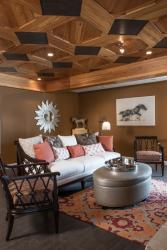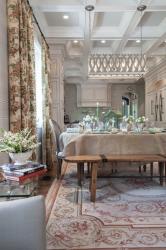Whether building a new home or renovating a dated one, perfecting a space down to the smallest detail can be stressful for any homeowner. While a pop of color or a unique piece of furniture can add personal flare to a room, many are now searching for a more dramatic way to make their home one-of-a-kind.
Our advice? Look up.
Changing up the ceiling style is one way to make a statement in a room that is often overlooked. There are many styles to choose from, and each style can be varied to fit what a homeowner wants to convey in their space, whether it begs for a modern, traditional or contemporary feel. “Most of what we’re seeing now is adding height,” says architect Jeff Day of Jeff Day + Associates. “People are pushing their ceilings up to 12-14 feet, but moving away from the slant of a vaulted ceiling that we’d seen in the past.”
All three of the architects we asked about ceiling style trends commented that ceilings are going higher. Jeannie Brendel of Brendel Architects explains that this switch in height (but not in detail) has to do with simplifying a space. “Homeowners are moving away from high-maintenance ceilings for a more sleek and modern feel,” she says. “Some are adding more to their ceilings, but it just depends on the home,” says Lauren Strutman of Lauren Strutman Architects. “You’ll see crown and cove molding in more traditional-style homes, faux beams in a room that’s going for a rustic feel and coffered or tray ceilings in modern homes to add some detail.”
When picking the right style for a home, the homeowner must ask themselves one question: what do I want my space to say?
Tray ceilings are created by raising a portion of a ceiling to add a second, higher level within the first. Though this style has been around for a long time, it is now being used in homes with modern designs, often combining with a coffered ceiling to add dimension. Coffered ceilings consist of geometric sunken panels, typically trimmed in white.
If you’re considering a tray or coffered ceiling, or even a combination of the two, one way to make it your own is to paint the raised portion or portions with an accent color. This will tie a room together and make a statement in an unusual place. “A ceiling doesn’t have to define the style of a space, but the amount of detail put into a ceiling can” explains Day. “For example, one piece of crown molding pushes a simplified traditional style, but a homeowner can add more levels of crown molding to make a space more ornate. Both are traditional, but they are still extremely different.”
These examples are just a few that a homeowner or designer can choose from. There are Eastern styles inspired by the domed and curved interior of mosques, cathedral ceilings that come to a point and span several floors and stretch ceilings with a layer of thin fabric and accented with dimmed lights above.
But not everyone is building a new home; some want to change the ceiling they already have. “It’s not uncommon in older homes to cut into roof trusses to add height,” says Strutman. “If someone wants to change their existing ceiling, they can just raise the height of the ceiling by going into the attic for that added space.”
Want to change your ceiling style without construction?
“There are ways to add personal flare without cutting into anything,” Jeannie Brendel explains. “Not only can a homeowner paint the ceiling a different color, but they can also add interesting details such as reclaimed wood, beadboard or shiplap. I’ve even seen someone cover the ceiling with tin for an old-time feel.”
Whether you’re building a new home or redecorating what you have, the ceiling is just as important to the style of your home as the rest of the room. Don’t let the space above you go to waste; make your ceiling your own.
Resources
Jeannie Brendel, Brendel Architects, 618-248-5687
Jeff Day, Jeff Day + Associates, 314-644-2775
Lauren Strutman, Lauren Strutman Architects, 636-537-0880











